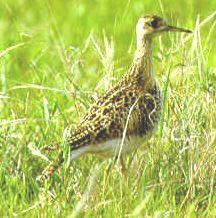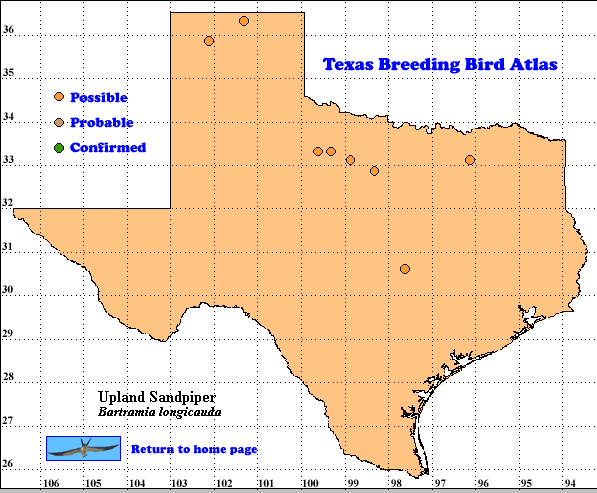Upland Sandpiper is a medium-sized shorebird with mostly terrestrial habits. It breeds in the temperate and subarctic regions of North America and winters on the pampas in southern South America.
In North America, Upland Sandpipers are uncommon spring and fall migrants and throughout much of their range are scarce and local breeders. During the breeding season, their numbers are greatest on the central Great Plains from northern Oklahoma to North Dakota (Sauer et al. 2005).
Upland Sandpiper is said to have bred in Texas in the nineteenth century at Gainesville, Cooke County (Oberholser 1974). In 1983, two adult and two juvenile birds were observed from late spring through early summer in Crosby County suggesting a successful breeding pair (M. Lockwood, pers. comm.). Birds thought to be possible breeders found during the TBBAP suggest that nesting may occur; observations by atlasers in suitable habitat coincide with their breeding phenology in adjacent plains states.
DISTRIBUTION: Spring migration occurs mid-March to early May and fall migration from July to early October. During migrations, Upland Sandpipers can be relatively common (very common in some years) through all parts of Texas east of the Pecos River Valley, and uncommon to rare through most of the Trans-Pecos (Oberholser 1974). They occur irregularly throughout June locally in the northern third of the state. There are numerous and widely scattered summer sightings throughout the state, but evidence of nesting is lacking (Oberholser 1974, K. Seyffert pers. comm.). They are accidental in winter.
SEASONAL OCCURRENCE: Most birds arrive on their breeding grounds paired and immediately establish territories (Peterjohn and Rice 1991), begin courtship, nest-building, and egg-laying. Because they tend to perch visibly on fence posts, telephone poles, or rocks, adult Upland Sandpipers are fairly easy to find (Terres, 1982). Their loud, distinctive song and conspicuous display flights enable territorial males to be regularly detected on roadside surveys (Sauer et al. 2005). Their nests are hidden in dense grasses and are very difficult to locate (Peterjohn and Rice 1991), and like many other shorebirds, Upland Sandpipers are mostly silent during incubation (Calme and Haddad 1996). Returning migrants may appear in Texas in early July making most summer sightings inconclusive (Lockwood and Freeman 2004).
The atlas map shows that the Upland Sandpiper is a possible breeder in the Panhandle, north-central Texas, and the Central Prairie region. Egg dates for Oklahoma are from June 1 to June 24, and young have been reported from June 12 to July 5. Kansas egg dates are April 21 to June 10, with a peak of egg-laying in early May (Johnsgard 1979). During the TBBA field work (1987-1992), birds were observed in suitable breeding habitat (short grassland, pastures, fallow fields, wheat fields, cropland, and along railroad right-of-ways) between May 5 and June 26.
BREEDING HABITAT: The Upland Sandpiper frequents large open meadows and fields, rough grasslands and prairies. In some regions it prefers moister tracts with more luxuriant vegetation, but it is most often found on quite dry ground, upland pastures, hayfields, and airports. In Texas, Stevenson (1942) reported Upland Sandpipers were regular summer residents on range and cultivated farm lands.
Their preferred breeding habitats are characterized by relatively flat, open grasslands where the vegetation is normally 0.3-0.6 m (1-2 ft.) high. Hilly terrain is normally avoided, even if the grasslands are otherwise suitable, as are overgrazed pastures and regularly mowed hayfields (Peterjohn and Rice 1991).
The nest is built in a slight depression in the ground and lined with dried vegetation. Nests are usually concealed in thick grass that arches over the nest hiding it from above (Johnsgard 1979). Clutch size is usually, 3 to 5; eggs have a creamy to pinkish-buff ground color and are evenly spotted with reddish browns, 45 x 32.5 mm (1.8 x 1.3 in.) (Bent 1929). In the Great Plains states, the incubation period averages 24 days, starting with the last egg. Both sexes share incubation and brooding. Upland Sandpipers are only known to raise a single brood per year. When the chicks are 30 days old they appear fully grown and are presumably fledged (Johnsgard 1979).
STATUS: Historically, abundant flocks of Upland Sandpipers were found in Texas. Their declining numbers were noticed a century ago, caused primarily by indiscriminate, unregulated hunting on their breeding and wintering grounds (Bent 1929). Other factors contributing to their decline are the conversion of native prairies to cropland, pesticides from the insects the sandpipers feed upon, early haying, and predation (Houston and Bowen, 2001).
TBBA data show the Upland Sandpiper to be irregular and widely scattered throughout the northern third of Texas in May and June as stated by Oberholser (1974). While unable to confirm breeding, atlasers did document new sight records for latilong 32098, quad H4 and 35102-G1, and new summer sight records for l33098-B8 and 30097-F5.
The lack of breeding records is not surprising due to the difficulty of locating nests. “The birds relieved each other at the nest…one bird would alight at a long distance, fold his wings, utter no cry, and, with head held low, walk through the grass, squatting lower and lower until finally he disappeared on the nest; then the female would retreat with the same caution, not spreading her wings till far from the eggs” (Bent 1929). Thus, locating Upland Sandpiper nests to confirm breeding takes much time and infinite patience.
Text by Ron Batie (1997)
Literature cited.
Bent, A. C. 1929. Life histories of North American shorebirds. Vol. 2. Bull. U. S.Nat. Mus. 146.
Calme, S. and S. Haddad. 1996. Peatlands: a new habitat for the Upland Sandpiper,Bartramia longicauda, in eastern Canada. Can. Field-Nat. 110: 328-330.
Houston, G. S. and.D. E. Bowen, Jr. 2001.Upland Sandpiper (Bartramia longicauda). In The Birds of North America, No. 580. (A. Poole and F. Gill, eds.). The Birds of North America, Inc., Philadelphia, PA.
Johnsgard, P. A. 1979. Birds of the Great Plains: breeding species and their distribution. University of Nebraska Press, Lincoln.
Lockwood, M. W. and B. Freeman. 2004. The TOS handbook of Texas birds. Texas A&M University Press, College Station.
Oberholser, H. C. 1974. The bird life of Texas, University of Texas Press, Austin.
Peterjohn, B. G. and D. L. Rice. 1991. The Ohio breeding bird atlas. Ohio Dept. Nat. Res., Columbus.
Sauer, J. R., J. E. Hines, and J. Fallon. 2005. The North American Breeding Bird Survey, results and analysis 1966-2005. Version 6.2 2006. USGS Patuxent Wildlife Research Center, Laurel MD < http://www.mbr-pwrc.usgs.gov/bbs>
Stevenson, J. O. 1942. Birds of the central panhandle of Texas. Condor. 44: 108-115.
Terres, J. K. 1982. The Audubon Society encyclopedia of North American birds. Alfred A. Knopf, New York.

